United States President Donald Trump aims to bring manufacturing back to the U.S. and with it the good old days of American factory towns, but the country might not have enough workers or the appetite for a return to the assembly lines.
With U.S. unemployment at 4.

2 per cent in March 2025, the U.S. labour market is too tight to bring back domestic manufacturing and the jobs would be less attractive to a modern-day workforce, CIBC Capital Markets economists Andrew Grantham and Avery Shenfeld said.
“There’s a tendency to romanticize the glory days of manufacturing employment from decades ago,” they said in a note on Tuesday. “But it’s worth remembering that meatpacking plants, or rows of sewing machine operators making T-shirts, are also part of the manufacturing sector, and while they are welcome sources of employment for some, today’s younger workers are more likely to see their ideal employer elsewhere.” Trump began imposing tariffs on imports shortly after becoming president for the second time to help bring production back to the U.
S. Part of the plan is already working in certain cases. Several companies, including Johnson & Johnson , Apple Inc.
, Honda Motor Co. Ltd. , Hyundai Motor Co.
and Nvidia Corp. , have all announced plans to boost U.S.
manufacturing. But there is still a long way to go. Grantham and Shenfeld estimate the U.
S. would need an additional 3.3 million workers to achieve a balanced trade on goods in the manufacturing sector, while a trade balance in just autos, metals and electronics would require 1.
8 million workers. “Unlike where we were at the turn of the millennium, or even more so, during the immediate aftermath of the 2008 financial crisis recession, we don’t have an overhang of unemployed manufacturers waiting to take positions that become available,” they said. “In both the factory sector and the overall economy, there are very few unemployed Americans relative to the number of open positions.
” Bringing back manufacturing jobs on a large scale would also require American workers to take a pay cut. Average hourly wages in manufacturing fell behind the overall private sector 10 years ago and widened during the pandemic even as more factories automated the lowest-paying jobs, the economists said. For example, the U.
S. has given up a lot of factory jobs to Germany since 1997, but the American household income gap had widened compared to Germany by 2019. “It’s not clear that shifting workers from where they are currently employed into the kind of manufacturing jobs that would be needed to substitute for imports would represent a gain,” Grantham and Shenfeld said.
On top of the recruiting challenges, tight immigration policies and an aging population in the U.S. would make filling these jobs even harder, they said.
“It would be a long road to either train a sufficient number of Americans or bring in immigrants with these skills, along with the entire nexus of facilities needed to replicate what’s now present in Asia,” they said. Questions about the federal election and your taxes? Join us on Wednesday, April 23 at 12 p.m.
to 1 p.m. ET, when tax expert Jamie Golombek will answer questions about the implications of the political parties’ platforms on personal taxes in a live Q&A.
With the CRA deadline nearing, there will no doubt be some last-minute tax talk, too. Register now and we’ll send you a link to the live chat on April 23. Sign up here to get Posthaste delivered straight to your inbox.
The Conservative Party of Canada became the last major party to release its costed platform on Tuesday, pledging to run fewer deficits than the Liberals, but without a forecast to a balanced budget. Several measures, including a tax cut on new homes, income tax cuts and axing the capital gains tax increase will cost the government billions under the Conservative plan, but the party is hoping that the cuts and deregulation will result in revenue gain and offset a portion of the cuts over the long run. The Conservatives are also expected $20 billion in tariff revenue.
Read more on the platform here. Canadian Club Toronto hosts event on charting Canada’s Arctic future Data: Canada new housing price index, United States new home sales and building permits for March Earnings: Rogers Communications Inc., First Quantum Minerals Ltd, TFI Intenational Inc.
, Cargojet Inc., Precision Drilling Corp., Philip Morris Inc.
IBM Corp., AT&T Inc., Boeing Co.
, Chipotle Mexican Grill Inc., Volvo AB Trump has crushed Canadians’ dreams of moving to the U.S.
, says new survey Canadian history to go on the block as Hudson’s Bay unwinds its empire Carney’s ‘spend less, invest more’ marketing catchphrase means more taxes are coming Poilievre vows not to impose a home equity tax as Liberals, NDP talk health care With Canada’s tax deadline just over a week away, many Canadians may unaware of the tax credits they may be eligible for. Sure, most Canadians know a home office or child care comes with some tax benefits, but so do medical expenses, tuition, paying student debts and moving. What’s more, unclaimed benefits are still available for up to five years.
Read more here. Are you worried about having enough for retirement? Do you need to adjust your portfolio? Are you starting out or making a change and wondering how to build wealth? Are you trying to make ends meet? Drop us a line at [email protected] with your contact info and the gist of your problem and we’ll find some experts to help you out while writing a Family Finance story about it (we’ll keep your name out of it, of course).
McLister on mortgages Want to learn more about mortgages? Mortgage strategist Robert McLister’s Financial Post column can help navigate the complex sector, from the latest trends to financing opportunities you won’t want to miss. Plus check his mortgage rate page for Canada’s lowest national mortgage rates, updated daily. Financial Post on YouTube Visit the Financial Post’s YouTube channel for interviews with Canada’s leading experts in business, economics, housing, the energy sector and more.
Today’s Posthaste was written by Ben Cousins with additional reporting from Financial Post staff, The Canadian Press and Bloomberg. Have a story idea, pitch, embargoed report, or a suggestion for this newsletter? Email us at [email protected] .
Bookmark our website and support our journalism: Don’t miss the business news you need to know — add financialpost.com to your bookmarks and sign up for our newsletters here.
Business

Posthaste: Holes emerge in Trump’s plan to bring back manufacturing

To achieve a balanced trade on goods, the U.S. would need an additional 3.3 million workers















